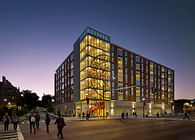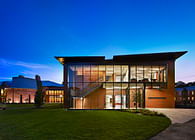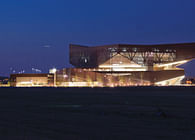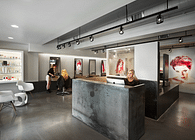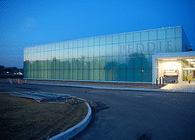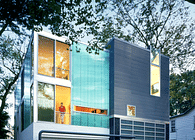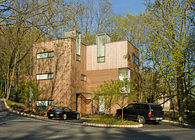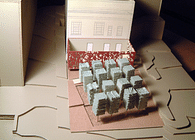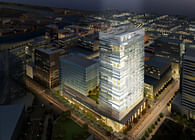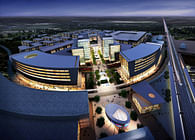
Princeton, NJ
SLIPSCAPE
A cast-in-place concrete and steel structure occupies the theoretical discourse between architecture and landscape. The natural contours of the lawn open the possibility for slipping the building below the landscape under a re-imagined lawn, the effect of which is a hybrid architectural form that is landscape and structure, surface and volume, roof and ground. SlipScape responds to the immediacy of the site context while negotiating the contradiction posed by the original symmetrical plan. As hybrid architecture, spaces are voids formed by internal and external forces: access, daylight, and topography. Geometries are inductive and operate within the x, y, z planes as post facto metrics in the absence of the normative grid.
The location is a corporate campus and the site is a prominent ceremonial lawn framed by the two massive masonry office buildings. The CEO imagined a new campus center as the virtual knot that would join the two stand-alone office buildings and unify the campus of executive management and technical staff. A cafeteria serves as social glue in realizing the objectives for loosening the aseptic culture, the sum of which translated into a re-contextualized built form.
A south-facing dining terrace is a metaphor for entry yet access is exclusively through the connecting concourses. Two central site walls shape and bifurcate the spaces and like the existing buildings they attempt to unite, never complete into a single closed object. Instead, they construct a light-filled figural void that indexes the contours of the circulation below and the sloping /folding of the roof plane above. What begins as a narrow slot of daylight morphs into a continuous surface of glass with a seventy-foot span.
Sustainability is a measure of the synthetic integration of the project architecture resulting in the formal, material and systems design concomitant with constructing sub-grade space. The reconstituted lawn as a means of site conservation reduces storm
water run-off and minimizes below grade structures, piping and eliminates heat islands. The thermal envelope and vegetative roof achieve 50% reduction of the U value through the use of concrete trombe walls. The glass roof achieves with optimal thermal conductivity and solar heat gain and light transmittance using 80% glass frit. Heating and air conditioning is a combination of radiant cooling and heating. The displacement ventilation allows the high ceiling space to be stratified reducing the heating and cooling requirements of the space, therefore reducing energy consumption.
Status: Built
Location: Franklin Lakes, NJ, US
Firm Role: Architect
